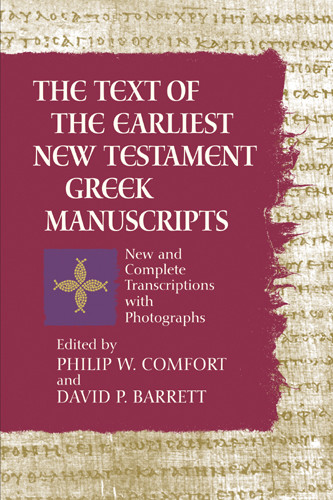Description of the Print Edition
Our version of this module represents the revised edition of Comfort and Barrett’s popular work, The Text of the Earliest New Testament Greek Manuscripts (Tyndale House Publishers: 2001). This is an important work for New Testament studies because it gives access, in one volume, to transcriptions of some of the earliest New Testament papyri, along with some additional majuscules. There are transcriptions of 69 manuscripts dating from the early 2nd to 4th centuries CE. In addition there are introductory remarks for each text, some of which are very extensive (such as the one for p4, 64, 67). Also of value are the many transcriptional notes made by the editors to explain some of the notable features of the texts, along with difficulties in the transcription process. Note: Due to licensing restrictions, the images contained in the print edition are not included in our edition.
Enhancements to the Accordance Edition
Personally, I’ve been anticipating the release of this project since I heard about it last year. We didn’t settle for simply producing an electronic edition of the book (although that in itself would have been very useful). Instead, we’ve created three modules out of it.
One of the reasons we were interested in this work was so that we could use the texts it contained to add to our growing collection of tagged NT MSS. However, the problem we were faced with was how best to organize them. Creating 69 different texts would have been cumbersome to develop, as well as organize and use within Accordance. So, the decision was made to treat it as we did the Dead Sea Scrolls Biblical Manuscripts, and create two texts: one in canonical order (GNTPAP-C), and one in manuscript order (GNTPAP-M). The former is a complete collation of the individual texts according their corresponding book/chapter/verse, a task which would be virtually impossible with the print edition (you would literally have to flip back and forth through the book for each verse you are working in, in order to accomplish anything similar), the latter a transcription of the texts in manuscript order as they appear in the print edition.
The texts also include full morphological tagging, giving you the ability to search for specific forms, including nomina sacra, and numerals. You’ll also notice that we’ve used our majuscule font, Sylvanus, which gives the texts a more authentic look. Then, we made the introductory material and transcriptional notes into a reference tool (GNTPAP-M Notes) that can be viewed as a separate tool (fully searchable, and indexed with 8 different fields), or in parallel with the texts in manuscript order.
One of the highlights of the SBL Annual Meeting was being able to demonstrate this new tool to the many scholars present. The feedback was overwhelmingly positive, and I was happy to see that many specialists in NT Textual Criticism and Papyrology were pleased with the work. I also got to spend some time with Philip Comfort, one of the editors of the book, to show him what we had done — he was very pleased as well.
When you combine this new module with the other text-critical tools that Accordance offers, you get some of the most advanced tools for text-critical research currently available. In an upcoming post I’ll show some examples of how this can be used in coordination with the newest version of the CNTTS Apparatus, the NA27 Apparatus and some of our other tagged NT MSS.

